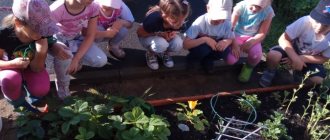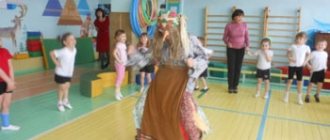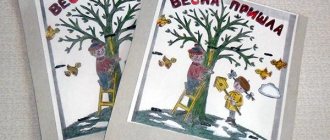MAGAZINE Preschooler.RF
“Forms of work with children and parents to form the foundations of environmental culture”Humanity is facing an environmental catastrophe. The reason for the violation of the ecological balance was the consumer attitude of people towards the world around them. Preschool childhood can rightfully be considered the beginning of the formation of an individual’s environmental orientation.
Environmental education in preschool age is just beginning; grains of environmental knowledge acquired in childhood will help the child navigate the surrounding reality and understand it correctly. But most importantly, they will lay the foundation for a conscious attitude towards nature, determining one’s place in it in the future.
I am sure that in order to reveal the beauty of nature to a child and teach him to see it, a teacher must be able to live in harmony with nature and captivate children by his example. We know that children are very observant and attentive to the words of the teacher, and they are good at distinguishing between positive and negative in the actions of adults.
Over the past years of work, I have created a holistic system that permeates all types of children's activities and is aimed at solving the following tasks:
- development of positive moral qualities that encourage children to comply with norms of behavior in nature and in society;
- education of ethical and aesthetic feelings, development of emotions;
- formation of cognitive, practical and creative skills of an environmental nature.
When building a system of environmental work, I paid special attention to the following main areas:
- The cognitive direction of work includes a cycle of educational activities:
- educational games,
- conversations,
- trips,
- performances,
- quizzes,
which contribute to a deeper expansion of pupils’ environmental knowledge.
- The educational and entertainment direction aims to introduce children to the components of living and inanimate nature, the influence of human activity on these components in a playful and entertaining way:
- theatrical performances on an environmental theme,
- holidays,
- environmental games,
- travel games.
- The next direction - The study of flora and fauna, landscapes of the native land, is associated with practical matters:
- joint activities with parents for group gardening,
- territory of preschool educational institution,
- work in the garden,
- flower garden design,
- bird feeding campaigns,
- making and hanging feeders.
All this helps to instill in students a caring attitude towards their native nature.
- The research direction of work is carried out within the framework of the following activities:
- project activities,
- excursions into nature,
- experiments,
which contribute to the development of thinking and analysis of the results obtained.
Ways to implement the environmental work system:
1. Creation of conditions (greening of the development environment)
A walk is a mini-trip that creates a special, unique world of sensations, emotional uplift and good mood. Children become more fun, more relaxed, and more sociable. Very impressionable children can easily be attracted to observing the color of the sky, the shape of trees, and the structure of plants. Such children are surprised by a drop of water, the transparency of ice, the murmuring of a stream, and the singing of birds.
In garden beds, children grow vegetable crops (onions, tomatoes, dill, peas, radishes, zucchini, etc.), observe their growth, and conduct experiments ( “In which soil do vegetables grow best?” , “On the influence of watering on plant life” )
Excursions to the park to the Obelisk along a large ecological trail are carried out systematically. We go to the same places, observe the same trees, bushes, grasses, follow the same types of insects and birds, and are amazed that the “ fixed world” changes and moves, colors and smells change , sounds, events. And this is all connected with the change of seasons.
In a corner of nature, different types of indoor plants are collected. In the winter, a mini-garden is placed on the windowsills, which allows the children to grow vegetables during the cold season.
In teaching and upbringing I practice an integrated systematic approach - from simple to complex. I conduct a series of observations of living objects with children. The work on the “Vegetable Garden on the Window” aroused great interest among both children and parents.
2. the way to create a system of environmental work - Work in the laboratory
Our group is equipped with an environmental laboratory, which has everything necessary to conduct various experiments.
In the experiments we carry out, we establish the relationship between air temperature and the state of water, consolidate knowledge about the properties of various natural materials (water transparency, clay solubility, snow adhesion, shape retention by wet sand, etc.).
To improve the environmental culture of preschoolers, various forms and methods of teaching are used:
- integrated GCD,
- observations,
- targeted excursions,
- environmental actions,
- experiments,
- reading fiction,
- conversations,
- staging,
- exhibitions on environmental themes,
- work in a corner of wildlife,
- competitions.
This year our group participated in the intermunicipal environmental theater competition and took 1st place.
Thus, with the help of educational activities, we try to develop in children a sense of responsibility, independence, morality, creativity, and the ability to see the meaning of their actions, i.e. to cultivate the child’s personal qualities, and of course, environmental culture, careful and responsible attitude towards the natural environment.
3. The way to create a system of environmental work is the research activity of preschoolers.
Research and search activity is the natural state of a child; he is determined to understand the world, he wants to know it. This is a huge opportunity for children to think, try, search, experiment, and most importantly, express themselves.
During research activities, children’s speech develops, children learn to ask questions: “How to do this?”, make requests: “Let’s do this,” “Let’s see what happens if...”, compare two states of the same object and find not only differences, but also similarities.
Working in an innovative mode, we became interested in project activities. The accumulated material was distributed so as to cover all sections of environmental education.
The method of project activity helps to combine the content of education from all areas of knowledge.
We involve parents and relatives of children in organizing search and creative activities, because One child cannot cope with this activity.
We offer tasks such as: making a model of a vegetable garden, collecting seeds, making feeders, publishing newsletters, etc.
At the moment, work on the topic “Project activities in environmental education of preschool children” continues.
4. The way to create a system of environmental work is Environmental education of parents.
Paying great attention to the joint activities of children and parents, we use the following forms of work:
- joint landscaping of the territory of the village,
- joint excursions,
- participation in competitions and exhibitions,
- publication of a newspaper for parents and children “Ecological Bulletin” ,
- joint release of newsletters, messages,
- participation of parents in environmental holidays.
Parents willingly and willingly participate in holding exhibitions of joint creative works. Crafts made from natural materials and drawings are presented here.
At parent meetings we introduce parents to the work of the environmental education group.
With the help of environmental newspapers and brochures, parents at home can test their children’s knowledge of ecology, check the signs of the seasons, and play environmental games.
The results of the work carried out indicate that the methods and techniques we use in preschool educational institutions support and develop the interest of preschoolers in acquiring new knowledge. Cooperation between educators and parents is carried out on all aspects of the issue of environmental education for children.
I would like to believe that love for our native nature will remain in the hearts of our students for many years and will help them live in harmony with the world around them.
| Next > |
Recommendations for organizing work with parents on environmental education for preschool children
RECOMMENDATIONS FOR ORGANIZING WORK WITH PARENTS ON ISSUES OF ENVIRONMENTAL EDUCATION FOR PRESCHOOL CHILDREN
RECOMMENDATIONS FOR DEVELOPING THE TOPICS FOR CONSULTATIONS FOR PARENTS ON ISSUES OF ENVIRONMENTAL EDUCATION FOR PRESCHOOL CHILDREN
Topics of consultations for parents
on environmental education for children
are usually formulated
taking into account the requests of parents
(if any) and
age, individual characteristics of children
(abilities, interest, rate of learning, etc.),
the content and structure
of organizing
the process of introducing preschoolers to nature and environmental education
.
The topic of the consultation can be formulated in the form of a question or a simple narrative phrase.
As a rule, for each specific topic of consultation it is indicated
and its
purpose.
For example,
PARENT CONSULTATION
topics could be:
— “How to develop preschoolers’ interest in nature in the context of family education
(or just in the family)? - here we can talk about different forms, methods, types of activities (games) of natural history content).
—
“Features of diagnosing the level of environmental education of preschoolers”
(here we can talk in general about the diagnostic process (meaning, process - forms, variants of tasks, assessment, etc.)
— “Options for gaming diagnostic tasks of environmental content for preschool children”
— “Game as a means of environmental education for preschool children”
— “Possibilities of educational games in the ecological development of preschool children”
— “Individual and age-related characteristics of preschoolers’ assimilation of ideas about objects and natural phenomena”
— “Features of organizing work on environmental education of children in kindergarten”
(discusses how work with children in kindergartens is organized to familiarize themselves with nature)
— “How to develop preschoolers’ ideas about animals and plants
(or one thing)
in home education?”
(you can take any other sections of the program)
— How to develop preschoolers’ understanding of inanimate natural phenomena (or seasonal changes in nature) in the context of home education?”
— “Features of organizing work on environmental education of preschoolers in the family”
(or specifically about forms, methods, etc.)
— “Features of environmental education for preschoolers 5-6 years old”
(or other age period)
— “The main problems (difficulties ,
complexities) in the development of
ideas about nature by preschoolers and their solutions”
— “How to form in children ideas about the relationship between a living organism and its environment?”
— “Environmental games for preschoolers”
— “Use of educational literature with natural history content for preschoolers at home”
— “Problematic and practical situations of natural history content for preschoolers and their use at home”
— “How to make the process of learning about nature interesting for preschoolers?”
— “Diagnostics of the level of environmental development of preschool children”
— “Features of developmental
(OR ONLY correctional)
work on environmental education with preschoolers”
- “How to form a consciously correct attitude towards nature in preschoolers?”
— “How to introduce preschoolers to the labor of people in nature?”
DEVELOPMENT OF RECOMMENDATIONS FOR PARENTS
ON ISSUES OF ENVIRONMENTAL EDUCATION OF PRESCHOOL CHILDREN
The main forms of joint work of kindergarten and family on issues of environmental education of children
- reports and messages at parent meetings and conferences;
— organizing exhibitions of visual aids with a description of their use;
— open classes of environmental content for parents (or integrated);
— joint project activities;
— photo exhibitions;
— group and individual consultations;
- conversations;
— folding folders, etc.
The main directions in working with parents, including environmental education for children, are reflected in the annual work plan of the preschool educational institution (for the year), and are specified in the long-term (for a certain period, usually a quarter) and calendar work plans for educators (for every day) . (Planning is the advance determination of the order and sequence of implementing the tasks of the program for the upbringing and training of preschoolers).
Contents and methods of conducting classes and conversations between parents and children in the family
is aimed at familiarizing with the peculiarities of the formation of ideas in preschoolers about living and inanimate nature, work in nature and depends on the level of development of the child.
The basic principles of organizing classes with children in the family
are the availability of the proposed material, consistency and systematicity in work, widespread use of visual aids, and the interest and activity of the children themselves.
Materials for classes on getting to know nature with children in the family:
small objects - “gifts of nature” (cones, acorns, tree leaves, etc.), toys that reflect the characteristics of natural objects;
cards and silhouettes of birds, animals, vegetables and fruits, etc. Drawing up brief recommendations for parents regarding the organization of work on environmental education of children in the family
Topic: “ How to make the process of learning about nature interesting for preschoolers?”
(School preparatory group (6-7 years old))
Recommendations for parents
Dear parents!
Nature is the habitat and part of the life of a modern person, including a small child. How to make the process of learning it interesting, meaningful and productive?
We bring to your attention some tips and recommendations:
1. Draw the child’s attention to the diversity, beauty, and uniqueness of objects and natural phenomena.
2. Organize work with children to familiarize themselves with nature in a play situation.
3. Consider the child’s wishes, his capabilities at a given, specific moment
4. Use any life situations for children to learn about natural objects and phenomena.
5. Praise and encourage your child more often.
6. Notice the child’s slightest progress in understanding nature.
7. Try to explain natural phenomena to your child in a form that he can understand.
8. Use a variety of forms, methods and means of introducing preschoolers to nature (observations in nature, hikes, walks, natural history literature, toys, models, experimentation, etc.)
7. Proceed from simple to complex.
8. Support your child’s initiative and interest in exploring nature independently
We wish you success!




